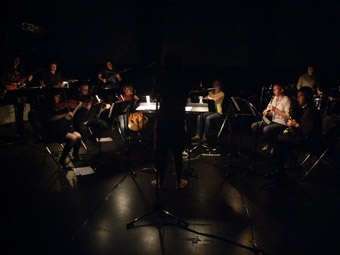new, new music for sydney
keith gallasch: chronology arts

Chronology Arts Ensemble playing Alex Pozniak's Illuminations
Formed in 2007, Chronology Arts is a new force in contemporary art music in Sydney, promoting and producing the creations of young composers with its young ensemble. The group is adding breadth and complexity to a new music scene in which groups as diverse as Ensemble Offspring, Halcyon and Song Company and adventurous New Music Network concerts stimulate an audience greedy for new challenges as well as opportunities to reflect on 20th century innovations that live on.
Chronology Arts will announce its 2010 program on September 4. Back in May, I attended its Gradations of Light concert in CarriageWorks' vast Bay 17. Undaunted, Chronology Arts filled the space with new music, light, responsive video art and ideas and, in Andrew Batt-Rawden's Rise—Gradation from Darkness to Light, moved musicians around and through the audience.
Rise emerges from a cello singing high against dark percussion. Other instruments are added, playing first from behind the audience and then joining the initiators in a rich texturing and swelling of sound with violin, viola and bird-like flute. The ensemble is supple, enveloping, accelerating like wind. A saxophone warbles. The pulse quickens into an aberrant march and then a strange dance, dwelling on an affecting flute passage, rising to ecstatic saxophoning, like the full glare of the sun. The world fades in a slow release breathed in long, sustained notes, the musicians ambling back into the dark. On a small screen in the stage foreground, coloured shapes have reconfigured themselves mysteriously in designer Ed Saribatir's Light Instrument, apparently in direct response to the played score.
Composer Batt-Rawden writes in his program note that sun-rise inspired the work, providing a metaphor for “facing our demons, rising to new challenges.” The result is, as he writes, something “of a primordial ritual…that touches on our cognitive-animal strength.” “Appollonian” might be an apt description for a work suggestive at once of a primal reality but at the same time one blessed with a sunny rationality—there's lucid construction, a sense of occasion and moments of intense feeling but with an optimism that elegantly eschews high drama.
Melody Eötvös' cool Figure Seven contrasts starkly with the warmth of Rise. It's “based on six digitally created creatures from a software program designed to map out evolutionary processes. Each section unfolds from a collection of pitches derived from a 'grid' of 36 squares superimposed over each picture (6 pitches along the y axis and 6 along the x axis). Therefore the subtle changes in the pitch collections mirror the gradual evolution of the images.” This is a work at once stark and delicate, its quietly insistent pulse relieved by pizzicato, downward glissandi and lyrical erhu phrasings (from Nicholas Ng), integrating an intriguing meme to this strand of Modernist evolution.
Ng's own work, Light channels: on circulation and percolation, is inspired by an 8th century Chinese text on alchemy, specifically “the flow of light energy through certain passages or channels in the human body.” The erhu is at the centre of the composition, again framed by Western instruments and tonalities. Gonging and glissandi, some striking, deep, flowing saxophone and jaunty flute and clarinet lines provide rich interplay. In a second movement solo, the erhu, increasingly and fascinatingly distorted, is amplified dramatically against pre-recorded sound (not unlike deep breathing and percolation) suggestive of physical interiority. The work then becomes almost meditative before dancing to a finish.
If there was a lot to take in aurally in Light channels, there were also visual demands. In the first movement, three large screens behind and above the musicians revealed a Rorschach-like triptych of initially abstract shapes folding in and out of themselves and gradually revealed to be a meditation on a tree, splitting, fusing and evolving. It's a work by Christopher Fullham that could stand on its own; here it seemed aptly complementary. In the second movement, clouds drifting against blue sky and criss-crossing each other proved less engaging if providing a kind of visual bass line in their quiet monumentality.
In Illuminations Alex Pozniak aims to generate “an elastic interaction of cells of material across the ensemble…with the instruments and instrumental section (winds, strings, electric guitars) negotiating different degrees of cohesion and liberty in textures that represent light as a dynamic source of energy.” The work opens with high whistlings and a growing sense of vibration replete with tumbling sax notes and rapid flute runs, high strings and guitar harmonics. Three electric guitars swell the scale of Illuminations, each soloing distinctively while accompanied by the other two, ranging from austere lyricism to a chugging slo-mo heavy metal and artful feedback before being joined by the balance of the ensemble in a beautiful collective drift to silence.
Scott Morrison's video response to Illuminations comprises unfocused lines—black, grey, white—running in vertical parallels and then intersected by horizontals. It's a gentle, unhurried work, serenely accompanying the growing passion of the score rather than mimicking its intensity.
Gradations of Light was a satisfying multimedia experience: an ambitious concert built thematically around light (actual and metaphysical) but also, for the most part, dextrously realised in inventive staging and engaging projections. Conductor Morgan Merrell calmly ensured that the ensemble ably managed the numerous demands of these welcome new compositions.
Works by Alex Pozniak will be the focus of a September 8 concert at Sydney University's Manning Bar, and the 2009 Chronology Arts season will end with a concert titled Playing in Tongues, December 9 at the Sydney Conservatorium of Music.
Chronology Arts, Gradations of Light, composers Andrew Batt-Rawden, Melody Eötvös, Nicholas Ng, Alex Pozniak, conductor Morgan Merrell, flute Jane Duncan, clarinet Toby Armstrong, saxophone Andrew Smith, viola Luke Spicer, cello Eleanor Betts, viola/violin Victoria Jacono, erhu Nicholas Ng, guitars Matthew McGuigan, Zane Banks, Matthew Kurukchi; CarriageWorks, Sydney, May 15; www.chronologyarts.net
RealTime issue #92 Aug-Sept 2009 pg. web






